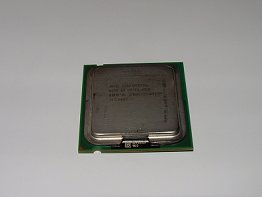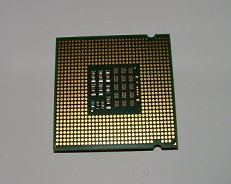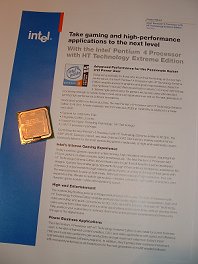 |
|
|
|
In the Forums... |

Posted: October 31st, 2004
With the firm push from Northwood to Prescott based Pentium 4's and later Xeon's being Intel's predominant goal throughout this year many have expected the same fate to surround the Extreme Edition series. Why this question has sprung to the minds of many is understandable, after all focussing as much production on the cheaper 90nm process brings several benefits. In fact if we take an overview on Intel's current microprocessor offerings it is apparent that already most are being manufactured at the smaller nanotechnology level. For whatever reasons Intel hasn't decided to demonstrate this move on their latest Extreme Edition, at least not yet anyway. This of course implies that new adopters of the now top 3.46GHz model are still going to end up exchanging their pennies for a 0.13 micron product. Although this news possibly triggers many wanting to ask the question "Why?" there is also a much more radiant side to this latest revelation. A prime truth to remind ourselves is a simple fact, any processor being an ancestry of the Prescott heritage means having a 31 stage pipeline. The latest Xeon DP line-up has already been victim of such change as visible in the Nocona core, an essentially calibrated version of Prescott circuitry. Since the Extreme Edition is derived from Xeons its amendment to a 90nm process would mean also inheriting the characteristics of the Prescott design. Both the latest Pentium 4E and Xeon processors suffer from encumbering performance hits when a pipeline stall occurs and perhaps most obvious excessive heat levels. If Intel chose to make the shift of manufacturing the Extreme Edition on a 90nm process it would no doubt employ the just cited Nocona specifics and bring along with it the two issues described. Since the Extreme Edition is all about offering best performance this could actually translate into Intel taking a step backwards by slowing down the IPC (Instructions Per Cycle) capability. Of course one could argue that they could rectify this trade off for cheaper production costs by increasing the frequency by over 200MHz, but this is anything but free from problems as heat levels would begin to take their toll. Instead of currently endeavouring down a path likely destined for less value a more feasible approach was decided on. Intel knows without any need to be reminded that their Northwood and Gallatin cores operate more efficiently at a given clock frequency when compared to Prescott and Nocona - there are some slight exceptions but overall this is the case. Considering what we have aforementioned about the Extreme Edition strictly wanting the best performance it seems a good thing that - for now at least - Intel has kept the Gallatin core alive within this current release of the 3.46GHz model - alive for as far as it can stretch. Granted that this means the absence of a few arguably desirable details as we will discuss soon the general synopsis is positive, especially if one insists on understanding the market segment this product is striving to attract. It is most probable however that Intel will finally be forced into shifting to a 90nm Extreme Edition for the next release given that at such high frequencies of >3.6GHz it might not be widely possible to otherwise retain enough strong yields. The appearance of such version would likely touch the raised issues of efficiency and heat but if as severe as in the Prescott Pentium 4 series remains to be seen. Until that day becomes a reality the Gallatin run Extreme Edition lives on to die another day. What adopting Prescott in the future has going for it is improved branch prediction, integer execution and scheduling. Whether these combined with the larger cache and longer pipeline make possible an equally if not greater efficient Extreme Edition only time will tell.


 Click images to enlarge.
|
||
|
| |||
|---|---|---|---|